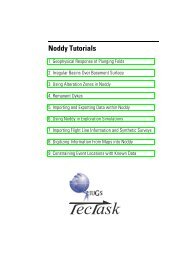Revised Eburnean geodynamic evolution of the ... - Tectonique.net
Revised Eburnean geodynamic evolution of the ... - Tectonique.net
Revised Eburnean geodynamic evolution of the ... - Tectonique.net
Create successful ePaper yourself
Turn your PDF publications into a flip-book with our unique Google optimized e-Paper software.
S. Perrouty et al. / Precambrian Research 204– 205 (2012) 12– 39 25<br />
Fig. 7. Histograms showing <strong>the</strong> range <strong>of</strong> measured susceptibility for each rock type found in <strong>the</strong> area. Several samples were remeasured under laboratory condition to confirm<br />
<strong>the</strong> field based data. The susceptibility <strong>of</strong> sediments is commonly ten times lower than volcanic rocks. Granitoid susceptibilities are variable with <strong>the</strong> highest values obtained<br />
from dioritic composition. Late doleritic dykes display high mag<strong>net</strong>ic susceptibility values.<br />
4.2.1. D1 (Eoeburnean)<br />
Our D1 corresponds to N-S shortening that produced kilometric<br />
scale folds within <strong>the</strong> Sefwi Group. Near Shama village in <strong>the</strong> SE<br />
<strong>of</strong> <strong>the</strong> Ashanti Belt, rare field evidence <strong>of</strong> D1 deformation exists as<br />
highly deformed micaschists that alternate with basaltic layers. The<br />
relatively competent basalts are strongly boudinaged and define a<br />
bedding parallel S1 foliation. In o<strong>the</strong>r regions, S1 is oriented approximately<br />
E-W (Fig. 10A) and is defined by <strong>the</strong> alignment <strong>of</strong> biotite<br />
(Fig. 11A). Large-scale F1 folds are imaged using high-resolution<br />
radar revealing major F1 folds within volcanoclastic units (S0) <strong>of</strong><br />
<strong>the</strong> Sefwi Group that are refolded by F3 folds (Fig. 6).<br />
Two discrete generations <strong>of</strong> quartz veins and pegmatite intrusions<br />
are distinguished. Early veins and intrusions are sub-parallel<br />
to bedding and <strong>of</strong>ten strongly boudinaged. According to <strong>the</strong>ir<br />
extension direction (subvertical at <strong>the</strong> time <strong>of</strong> formation for veins<br />
parallel to bedding), <strong>the</strong>y should have formed pre or syn-D1. Second<br />
Table 5<br />
Ranges <strong>of</strong> density values measured on 26 samples <strong>of</strong> <strong>the</strong> main lithologies in Ghana<br />
(this study) and in Burkina Faso (Baratoux et al., 2011).<br />
Unit Density ranges (g/cm 3 )<br />
This study Baratoux et al.<br />
(2011)<br />
Hasting<br />
(1978) a<br />
Dolerite (Sill and<br />
Dykes)<br />
2.87–2.90 2.92–2.93<br />
Mpohor Mafic Complex<br />
(Gabbro, Diorite)<br />
2.65–3.03<br />
<strong>Eburnean</strong> granitoids 2.58–2.75 2.60–3.25 2.41–2.76<br />
Eoeburnean granitoids 2.76–2.89<br />
Tarkwa Group<br />
(Conglomerates,<br />
Quartzites, Phyllites)<br />
2.68–2.99 2.71–2.77 2.45–2.84<br />
Kumasi Group<br />
(Birimian Phyllites)<br />
2.69 2.71–2.74<br />
Sefwi Group (Birimian)<br />
Cape Coast Mica<br />
Schists<br />
2.65<br />
Volcanoclastics 2.70–2.84 2.66–2.99 2.74–3.00<br />
Basalts/Andesites 2.84–2.93 2.72–2.97<br />
Gabbros 3.01 3.07–3.11<br />
a Density ranges after Hasting (1978, unpublished report referenced in Barritt and<br />
Kuma (1998)).<br />
generation veins and pegmatites cross-cut this composite S0–S1<br />
fabric and were developed during D1. Both generations are refolded<br />
during subsequent D3 shortening.<br />
D1 deforms only <strong>the</strong> Sefwi Group basement, and is not observed<br />
in <strong>the</strong> overlying Kumasi and Tarkwa groups. This relationship suggests<br />
that <strong>the</strong>se younger sedimentary packages were deposited<br />
after D1 and before subsequent deformation events (D3–D6).<br />
4.2.2. D2<br />
D2 corresponds to an extensional phase associated with <strong>the</strong><br />
opening <strong>of</strong> <strong>the</strong> Kumasi and Akyem basins into which <strong>the</strong> Kumasi<br />
Group was deposited (Fig. 1). On <strong>the</strong> western side <strong>of</strong> <strong>the</strong> Ashanti Belt<br />
at <strong>the</strong> Prestea and Bogoso mines, <strong>the</strong> west-dipping Ashanti Fault<br />
marks <strong>the</strong> contact between Sefwi Group basement and Kumasi<br />
Group sediments. The early history <strong>of</strong> this fault contact is obscured<br />
by significant thrust and shear reactivation during D3 and D4.<br />
On <strong>the</strong> eastern side <strong>of</strong> <strong>the</strong> belt, in Damang, <strong>the</strong> Sefwi/Tarkwa<br />
Group contact has been faulted and sheared during later deformation.<br />
This sheared contact is represented by a 2 cm thick<br />
anastomosed fabric that was probably created during D3/D4 shear<br />
reactivation <strong>of</strong> an original sedimentary contact (erosion surface), or<br />
by reactivation <strong>of</strong> an existing faulted contact that was controlling<br />
<strong>the</strong> development <strong>of</strong> <strong>the</strong> Tarkwa Basin in <strong>the</strong> eastern Ashanti Belt. As<br />
a consequence <strong>of</strong> a strong overprinting <strong>of</strong> <strong>the</strong> original sedimentary<br />
contacts during <strong>Eburnean</strong> deformation, <strong>the</strong> tectonic context <strong>of</strong> <strong>the</strong><br />
Tarkwa Group deposition remains unclear.<br />
4.2.3. D3 (<strong>Eburnean</strong>)<br />
D3 deformation is conspicuous within both <strong>the</strong> Birimian and<br />
Tarkwaian units in <strong>the</strong> study area. NW-SE shortening produced km<br />
scale folds and a strong sub vertical crenulation cleavage within<br />
<strong>the</strong> Birimian and Tarkwaian units (striking around N040; Fig. 10A).<br />
Stereo<strong>net</strong>s <strong>of</strong> bedding from <strong>the</strong> Kumasi Group and Tarkwa Group<br />
define a single major folding event associated with NW-SE shortening.<br />
However, <strong>the</strong> orientation <strong>of</strong> bedding within <strong>the</strong> Sefwi Group<br />
reflects <strong>the</strong> interference between D1 and D3 folds (Fig. 10A). The<br />
overprinting between F1 and F3 fold occurs across <strong>the</strong> region at<br />
multiple scales. In <strong>the</strong> Sefwi Group near Shama village, a composite<br />
S0–S1 foliation is crenulated and partially transposed along <strong>the</strong><br />
S3 cleavage (Fig. 11A). Ptygmatic F3 folds are also found where <strong>the</strong>y




